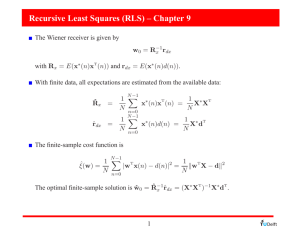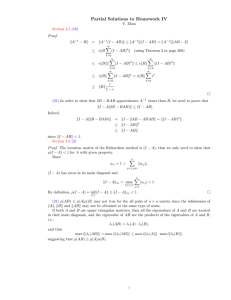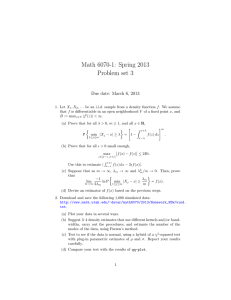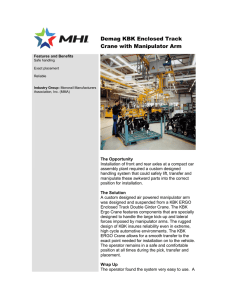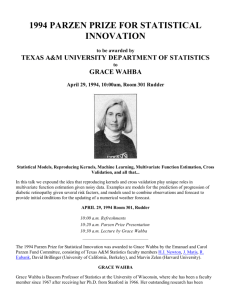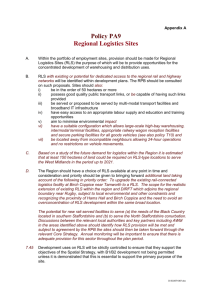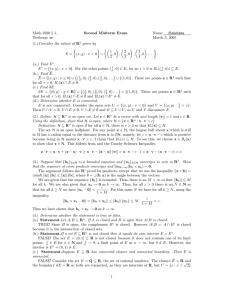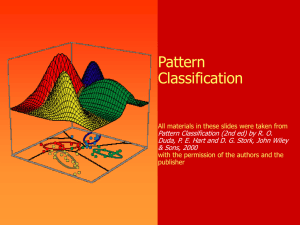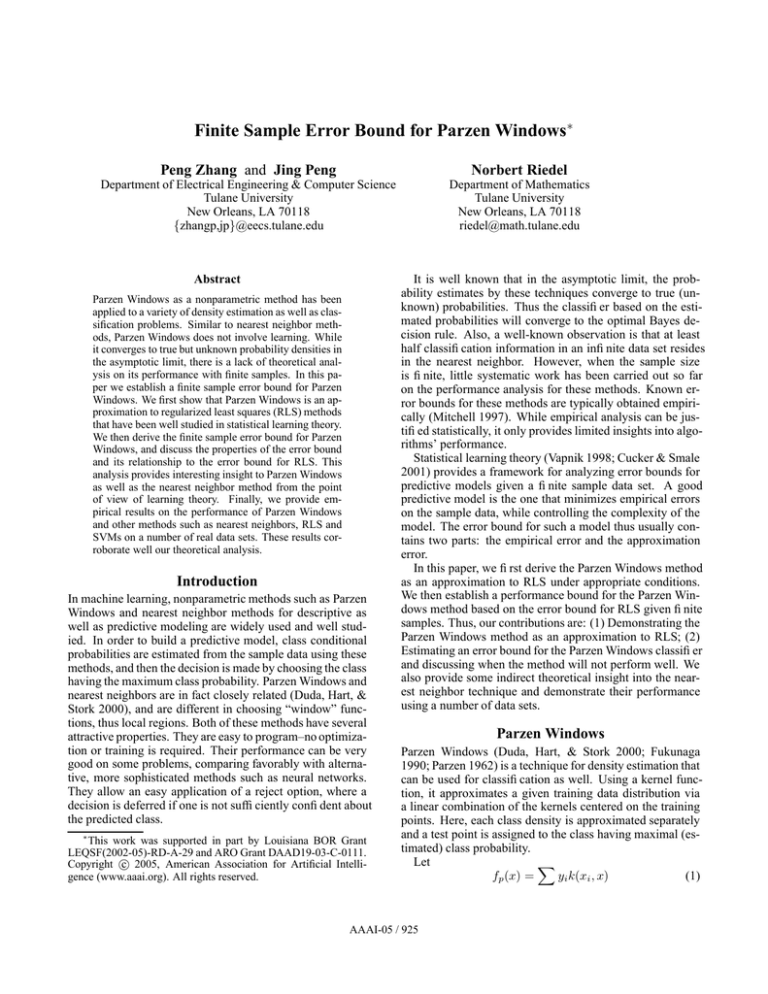
Finite Sample Error Bound for Parzen Windows∗
Peng Zhang and Jing Peng
Norbert Riedel
Department of Electrical Engineering & Computer Science
Tulane University
New Orleans, LA 70118
{zhangp,jp}@eecs.tulane.edu
Department of Mathematics
Tulane University
New Orleans, LA 70118
riedel@math.tulane.edu
Abstract
Parzen Windows as a nonparametric method has been
applied to a variety of density estimation as well as classification problems. Similar to nearest neighbor methods, Parzen Windows does not involve learning. While
it converges to true but unknown probability densities in
the asymptotic limit, there is a lack of theoretical analysis on its performance with finite samples. In this paper we establish a finite sample error bound for Parzen
Windows. We first show that Parzen Windows is an approximation to regularized least squares (RLS) methods
that have been well studied in statistical learning theory.
We then derive the finite sample error bound for Parzen
Windows, and discuss the properties of the error bound
and its relationship to the error bound for RLS. This
analysis provides interesting insight to Parzen Windows
as well as the nearest neighbor method from the point
of view of learning theory. Finally, we provide empirical results on the performance of Parzen Windows
and other methods such as nearest neighbors, RLS and
SVMs on a number of real data sets. These results corroborate well our theoretical analysis.
Introduction
In machine learning, nonparametric methods such as Parzen
Windows and nearest neighbor methods for descriptive as
well as predictive modeling are widely used and well studied. In order to build a predictive model, class conditional
probabilities are estimated from the sample data using these
methods, and then the decision is made by choosing the class
having the maximum class probability. Parzen Windows and
nearest neighbors are in fact closely related (Duda, Hart, &
Stork 2000), and are different in choosing “window” functions, thus local regions. Both of these methods have several
attractive properties. They are easy to program–no optimization or training is required. Their performance can be very
good on some problems, comparing favorably with alternative, more sophisticated methods such as neural networks.
They allow an easy application of a reject option, where a
decision is deferred if one is not sufficiently confident about
the predicted class.
∗
This work was supported in part by Louisiana BOR Grant
LEQSF(2002-05)-RD-A-29 and ARO Grant DAAD19-03-C-0111.
c 2005, American Association for Artificial IntelliCopyright gence (www.aaai.org). All rights reserved.
It is well known that in the asymptotic limit, the probability estimates by these techniques converge to true (unknown) probabilities. Thus the classifier based on the estimated probabilities will converge to the optimal Bayes decision rule. Also, a well-known observation is that at least
half classification information in an infinite data set resides
in the nearest neighbor. However, when the sample size
is finite, little systematic work has been carried out so far
on the performance analysis for these methods. Known error bounds for these methods are typically obtained empirically (Mitchell 1997). While empirical analysis can be justified statistically, it only provides limited insights into algorithms’ performance.
Statistical learning theory (Vapnik 1998; Cucker & Smale
2001) provides a framework for analyzing error bounds for
predictive models given a finite sample data set. A good
predictive model is the one that minimizes empirical errors
on the sample data, while controlling the complexity of the
model. The error bound for such a model thus usually contains two parts: the empirical error and the approximation
error.
In this paper, we first derive the Parzen Windows method
as an approximation to RLS under appropriate conditions.
We then establish a performance bound for the Parzen Windows method based on the error bound for RLS given finite
samples. Thus, our contributions are: (1) Demonstrating the
Parzen Windows method as an approximation to RLS; (2)
Estimating an error bound for the Parzen Windows classifier
and discussing when the method will not perform well. We
also provide some indirect theoretical insight into the nearest neighbor technique and demonstrate their performance
using a number of data sets.
Parzen Windows
Parzen Windows (Duda, Hart, & Stork 2000; Fukunaga
1990; Parzen 1962) is a technique for density estimation that
can be used for classification as well. Using a kernel function, it approximates a given training data distribution via
a linear combination of the kernels centered on the training
points. Here, each class density is approximated separately
and a test point is assigned to the class having maximal (estimated) class probability.
Let
X
fp (x) =
yi k(xi , x)
(1)
AAAI-05 / 925
where x ∈ Rn is a predictor vector, y ∈ R is the class label,
k() is a kernel function. The Gaussian kernel
k(x, x0 ) = e−
kx−x0 k2
σ2
.
(2)
is commonly used. For the binary case, the resulting Parzen
Windows classifier is very simple
X
f˜p (x) = sign(
yi k(xi , x)).
(3)
Notice that multiplying it by any positive constant will
not change it. The Parzen Windows does not require any
training and can be viewed as a generalization of k-nearest
neighbor techniques. Rather than choosing the k nearest
neighbors of a test point and labeling the test point with the
majority of its neighbors’ votes, one can consider all points
in the voting scheme and assign their weight by the kernel
function. With Gaussian kernels, the weight decreases exponentially with squared distance, so far away points are practically irrelevant. The width σ of the Gaussian kernel determines the relative weighting of near and far points. Tuning this parameter controls the predictive power of the system. Although the Parzen Windows classifier performs well
asymptotically (Duda, Hart, & Stork 2000), it may fail to do
so in applications with limited samples.
Regularized Least Squares Method
The regularized least squares method has been studied for
a long time, under different names. In statistics, ridge regression (Hoerl & Kennard 1970) has been very popular for
solving badly conditioned linear regression problems. After
Tikhonov published his book (Tikhonov & Arsenin 1977),
it was realized that ridge regression uses the regularization
term in Tikhonov’s sense. In the 1980’s, weight decay was
proposed to help prune unimportant neural network connections, and was soon recognized (J. Hertz & Palmer 1991)
that weight decay is equivalent to ridge regression.
In the framework of statistical learning theory, the RLS
algorithm has been revisited in (Poggio & Smale 2003), and
as regularization networks in (Evgeniou, Pontil, & Poggio
2000). Most recently, the error bound for it given a finite
sample data set was developed in (Cucker & Smale 2002).
Here we briefly summarize the theory.
The RLS algorithm minimizes the following regularized
functional:
1 X
(yi − f (xi ))2 + λkf k2k ,
m i=1
m
m
X
ci k(x, xi ).
where A(λ) (the approximation error in this context) is
−1
A(λ) = λ1/2 kLk 4 fρ k2 .
RLk
is an operator defined as
0
f
(x
)k(x, x0 )dρX . The sample error is
X
Lk f (x)
=
32M 2(λ + Ck )2 ∗
v (m, δ),
(9)
λ2
where M is a positive constant which is chosen to satisfy
|f (x) − y| ≤ M , and v ∗ (m, δ) is the unique solution of
m 3
4m
v − ln(
)v − cv = 0.
(10)
4
δ
cv > 0 is a constant. Ck is defined by:
Ck = max{1, sup |k(x, t)|},
(11)
x,t∈X
where k(x, t) is a kernel function, and for the Gaussian kernel, Ck = 1.
Finding the optimal solution of RLS is equivalent to finding the best tradeoff between A(λ) and S(λ) for given training data. That is, to minimize S(λ) + A(λ) over λ > 0.
There is a unique solution - a best λ choice in theory (Cucker
& Smale 2002). In real applications, we usually find the λ
through cross-validation.
Parzen Windows as Approximation to RLS
In this section we show that Parzen Windows can be viewed
as an approximation to RLS. In the discussion, we use the
∞-norm for both matrices
and vectors. That is, for a matrix
P
A, kAk∞ = maxi { j |aij |}, and for a vector x, kxk∞ =
maxi {xi }.
Also for the sake of simplicity, we use the notation k · k
to represent the ∞-norm in the following discussion. This
norm, however, should not be confused with the norm used
in the previous sections.
Lemma 1 Let B = K − I, where K is the kernel matrix
Kij = k(xi , xj ),k is the Gaussian kernel (2), and I is the
identity matrix of proper size. If λ > kBk−1
m , we have
(K + λmI)−1 =
∞
X
(−1)i d−i−1 B i ,
i=0
where d = 1 + λm.
Proof
(5)
i=1
where the coefficients ci s are solved by the key algorithm
(mλI + K)c = y.
(8)
S(λ) =
(4)
where λ is the regularization parameter, and kf k2k the norm
in the hypothesis space Hk induced by the kernel k.
The minimizer exists and is unique and is given by (Poggio & Smale 2003)
fλ,z (x) =
Let fλ,z be the optimum for the regularized problem as exhibited in Equation (4), and fρ the true input-output function, then
Z
(fλ,z − fρ )2 dρX ≤ S(λ) + A(λ),
(7)
(6)
AAAI-05 / 926
kd−1 Bk = d−1 kBk
kBk
=
(1 + λm)
kBk
<
(1 + kBk − 1)
=1
Using B = K − I, we can write
(K + λmI) = dI + B = d(I + d−1 B).
Then
(K + λmI)−1 = d−1 (I + d−1 B)−1 .
(12)
−1
When kd Bk < 1, it follows that (the Neumann series)
∞
X
(I + d−1 B)−1 =
(−1)i d−i B i .
i=0
And
(K + λmI)−1 =
∞
X
(−1)i d−i−1 B i .
Error Bound for Parzen Windows
We now establish the error bound for the Parzen Windows
function fp in (1). We split the error for fp into two parts.
The first part is the error between fp and RLS fλ,z . The
second part is the error between fλ,z and the true target fρ .
By combining these two terms we obtain the error bound for
Parzen Windows.
Lemma 3 Let λ > kBk−1
m . Then
Z
(fp − fρ )2 dρX ≤ 2(D(λ) + S(λ) + A(λ)),
i=0
(13)
(14)
Proof First we prove:
is:
i
=
Z
1 X
yi k(xi , x)).
(
d i
Thus Lemma 1 states that under appropriate conditions, the
Parzen Windows classifier is an approximation to RLS.
Let c = (K + λmI)−1 y. We now ask: How well does
our ĉ approximate c? From Lemma 1 we have
(K + λmI)−1 = d−1 (I − d−1 B + d−2 B 2 + · · · ).
Let
E = (I − d−1 B + d−2 B 2 + · · · ).
(15)
Then
c = d−1 Ey.
(16)
We can now establish a upper bound for the approximation
error |c − ĉ|.
Lemma 2 Let c and ĉ as in (16) and (13), respectively. Then
kBk
kc − ĉk ≤
,
d(d − kBk)
where d = 1 + λm and B = K − I.
Proof From Eqs (13), (15) and (16) we have
c − ĉ = −d−2 By + d−3 B 2 y − d−4 B 3 y + · · · .
Then, observing that kyk = 1 (since y ∈ {−1, +1})
kc − ĉk = k − d−2 By + d−3 B 2 y − d−4 B 3 y + · · · k
≤ kd−2 Byk + kd−3 B 2 yk + kd−4 B 3 yk + · · ·
Since
kBk
d
= kd−2 Bk + kd−3 B 2 k + kd−4 B 3 k + · · ·
kBk
= 2 (1 + kd−1 Bk + kd−2 B 2 k + · · · ).
d
< 1, it follows that
≤ 1 + d−1 kBk + d−2 kBk2 + · · ·
d
=
.
d − kBk
Therefore,
kc − ĉk ≤
kBk
d
kBk
=
.
d2 d − kBk
d(d − kBk)
R
X (fp
(fp − fλ,z )2 dρX ≤
X
S(λ) and A(λ)) are given
− fλ,z )2 dρX ≤ D(λ). That
λ2 (λm
kBk2
.
+ 1 − kBk)2
(18)
From (5) and (14), we have:
Z X
Z
m
( (ci − ĉi )k(xi , .))2 dρX
(fp − fλ,z )2 dρX =
X
≤
Z
X i=1
m
X
(
kBk
k(xi , .))2 dρX
d(d − kBk)
X i=1
m
X
≤ max |
x
i=1
kBk
k(xi , .)|2
d(d − kBk)
kBk
≤(
) 2 m2
d(d − kBk)
kBk2
≤ 2
.
λ (λm + 1 − kBk)2
Thus
Z
Z
2
(fp − fρ ) dρX =
(fp − fλ,z + fλ,z − fρ )2
X
X
Z
Z
(fλ,z − fρ )2
(fp − fλ,z )2 +
=
X
X
Z
+ 2 (fp − fλ,z )(fλ,z − fρ )
ZX
Z
2
≤ 2 (fp − fλ,z ) + 2 (fλ,z − fρ )2
X
X
≤ 2(D(λ) + S(λ) + A(λ)).
1 + kd−1 Bk + kd−2 B 2 k + · · ·
= 1 + d−1 kBk + d−2 kB 2 k + · · ·
kBk2
λ2 (λm+1−kBk)2 ,
where D(λ) =
by (9) and (8).
Let
ĉ = d−1 y.
We arrive at the Parzen Windows function (1)
X
fp (x) =
ĉi k(xi , x)
(17)
X
Discussion
Now let us take a look at the error bound. The error bound
is a function of λ, training data size m, and indirectly the
kernel function k (affecting v ∗ (m, δ)). M is a positive constant that is chosen to satisfy |f (x) − y| ≤ M . Ck is determined by the kernel function. For the Gaussian kernel
it is 1, as we showed before (Eq. (11)). Here we consider
that we are given a fixed training data size m and the kernel function k, then the error bound is a function of λ only
AAAI-05 / 927
.We will minimize the RLS error bound S(λ) + A(λ) for
λ > 0. To be the minimum of S(λ) + A(λ), it is necessary
that −S 0 (λ) = A0 (λ). Taking derivatives, we obtain
A(λ)
A0 (λ)
00
A (λ)
1/2
A(λ)
−1
kLk 4 fρ k2 ,
= λ
1 −1/2 − 41 ,
λ
kLk fρ k2 ,
=
2
1
−1
= − λ−3/2 kLk 4 fρ k2 .
4
S(λ)
S(λ)
−S 0 (λ)
00
−S (λ)
λ*
0
Similarly,
λ
−S′(λ)
32M 2 (λ + Ck )2 ∗
v (m, δ),
λ2
C2
Ck
= 64M 2 ( 2 + 3k )v ∗ (m, δ),
λ
λ
3C 2
2 2Ck
= −64M ( 3 + 4k )v ∗ (m, δ).
λ
λ
=
A′(λ)
−1
Since kLk 4 fρ k2 > 0, v ∗ (m, δ) > 0, both A(λ) and S(λ)
are positive functions. A(λ) strictly increases in (0, +∞),
while S(λ) strictly decreases in (0, +∞) and converges to a
positive constant 32M 2 v ∗ (m, δ). A0 (λ) is a positive function strictly decreasing in (0, +∞). −S 0 (λ) is a positive
function monotonically decreasing in (0, +∞). The question is: is there a unique λ∗ > 0 such that
−S 0 (λ∗ ) = A0 (λ∗ )?
Let right hand side be: R(λ) = A0 (λ), and the left hand
side be: L(λ) = −S 0 (λ). Both L(λ) and R(λ) are monotonically decreasing functions. We consider λR(λ) and
λL(λ): λR(λ) is a monotonically increasing positive function in (0, +∞) and λR(λ) → 0+ when λ → 0+ . However λL(λ) is still monotonically decreasing in (0, +∞),
and when λ → 0+ , λL(λ) → +∞. Then there must be
a unique solution λ∗ > 0 such that λ∗ L(λ∗ ) = λ∗ R(λ∗ ). It
is easy to see that if L(λ) = R(λ) has more than one distinct
solutions in (0, +∞), then so does λL(λ) = λR(λ). That
contradicts the fact for λL(λ) = λR(λ). So L(λ) = R(λ)
must have a unique solution. That is, there is a unique λ∗ in
(0, +∞) such that A0 (λ∗ ) = −S 0 (λ∗ ). Figure 1 shows the
error bound curves.
Now let us take a look at D(λ), the first term of the upper
bound for the Parzen Windows classifier. We take derivatives for D(λ):
kBk2
λ2 (λm + 1 − kBk)2
2kBk2
2kBk2 m
−D0 (λ) = 3
+
λ (λm + 1 − kBk)2
λ2 (λm + 1 − kBk)3
2
8kBk2 m
6kBk
−
−D00 (λ) = − 4
λ (λm − 1 + kBk)2
λ3 (λm + 1 − kBk)3
2 2
6kBk m
− 2
λ (λm + 1 − kBk)4
D(λ) =
Notice that λ can not be chosen arbitrarily in (0, +∞)
in the upper bound (17). Instead, it is only in the range
λ
λ*
0
Figure 1: RLS: balance between sample error and approximation error.
(max{ kBk−1
m , 0}, +∞). D(λ) is a positive function strictly
0
decreasing in (max{ kBk−1
m , 0}, +∞). −D (λ) is positive
kBk−1
function decreasing in (max{ m , 0}, +∞). We will
consider: is there a unique λ# in (max{ kBk−1
m , 0}, +∞)
such that
−2D0 (λ) − 2S 0 (λ) = 2A0 (λ)
at λ# ?
In this case, the right hand side is: R(λ) = 2A0 (λ), and
the left hand side be: L(λ) = −2D 0 (λ) − 2S 0 (λ). Note
that now λL(λ) is defined and monotonically decreasing in
kBk−1
(max{ kBk−1
m , 0}, +∞), and when λ → max{ m , 0},
λL(λ) → +∞. The proof are simply the same as for RLS,
and there is a unique λ# in (max{ kBk−1
m , 0}, +∞) such that
−2D0 (λ) − 2S 0 (λ) = 2A0 (λ). Figure 2 shows the error
bound curves.
Notice that λ actually is not a parameter of Parzen Windows. When λ > kBk−1
m , Parzen Windows is an approximation to RLS and its error bound can be derived from that for
RLS. But the error for Parzen Windows does not depend on
λ. We thus establish the following:
Theorem 4 Parzen Window’s error bound is:
Z
(fp − fρ )2 dρX ≤ 2(D(λ# ) + S(λ# ) + A(λ# )), (19)
X
where
2
D(λ)
32M (λ+Ck )
λ2
#
2
=
kBk2
λ2 (λm+1−kBk)2 ,
S(λ)
−1
λ1/2 kLk 4 fρ k2
0
0
=
;
v ∗ (m, δ) and A(λ) =
and λ is the unique solution of A0 (λ) = −S (λ) − D (λ).
Compared to RLS, the minimal point of the error bound
for Parzen Windows is pushed toward right, i.e., the crossing between 2A0 (λ) and −2D0 (λ) − 2S 0 (λ) is shifted to the
AAAI-05 / 928
2A(λ)
2D(λ)+2S(λ)
0
λ#
λ
−2D′(λ)−2S′(λ)
2A′(λ)
0
(||B||−1)/m
#
λ
λ
Figure 2: Parzen Windows error bound
right, as shown in Figure 2. The error bound for Parzen Windows is twice that of RLS’s plus 2D(λ). Besides, optimal
, the
performance may require λ∗ to be less than (||B||−1)
m
barrier that the Parzen Windows can not cross. As a consequence, the performance of Parzen Windows will be much
worse than RLS in such situations.
Experiments
We now examine the performance of Parzen Windows, RLS,
and SVMs on a number of UCI data sets and an image data
set. We also include the k-nearest neighbor method (k=3) in
the experiments, since as we discussed before, the Parzen
Windows classifier can be viewed a generalization of the
nearest neighbor classifier. For simplicity, we choose only
binary classification problems. For data sets that include
multiple classes, we transfer them into a binary classification problem by combining classes (e.g. glass data) or by
choosing only two classes from the data sets (for example,
we choose only ’u’ and ’w’ from the Letter data). All data
has been normalized to have zero mean and unit variance
along each variable.
We randomly select 60% of the data as training data to
build classifiers, and the rest (40% of data) as test data. We
repeat this process 10 times to obtain average error rates. For
the Parzen Windows classifier, there is only one parameter
to tune: σ of the Gaussian kernel. For RLS, there are two
parameters to tune: σ and λ. For SVMs, there are also two
parameters to tune: σ and C (which controls the softness of
the margin (Cristianini & Shawe-Taylor 2000)). These parameters are chosen by ten-fold cross-validation. The classification results are shown in Table
On some data sets (e.g. heart-h and iris), the performance
of Parzen Windows is close to RLS. For those data sets, it
turns out that RLS tends to favor large λ values, or when using larger λ values, its performance does not sacrifice much.
However, on the ionosphere data set, the performance of
Parzen Windows is significantly worse than RLS. For this
data set, RLS prefers small λ value (0.000 in the table means
that average λ values picked by RLS is less than 0.001) and
its performance becomes poor quickly when larger λ values
are used. Remember that, Parzen Windows, as an approximation to RLS, only approximates RLS well when the value
of λ is large.
So why is ionosphere so different? This is because, the
ionosphere data has more irrelevant dimensions. This is also
noticed and demonstrated by many others. For example in
(Fukumizu, Bach, & Jordan 2004), it is shown that when the
data (originally 33 dimensions) are carefully projected onto
a subspace with roughly 10 dimensions, SVMs can perform
significantly better.
We have also evaluated these classifiers on an image data
set composed of two hundred images of cat and dog faces.
Each image is a black-and-white 64 × 64 pixel image, and
the images have been registered by aligning the eyes.
For the image data, it is more obvious that most dimensions are noise or irrelevant. It is well known that for the
image data, only 5% dimensions contain critical discriminant information. So for the cat and dog data, RLS prefers
extremely small λ values. Parzen Windows cannot approximate RLS well in such cases, and its performance is significantly worse. The results are listed in the last row of Table
1.
Then why does RLS choose small λ values in those data
sets? Remember that λ is the regularization parameter.
When choosing a larger λ, RLS selects smoother functions.
A smoother function (function with a smaller norm) can
learn quite well for simple problems. However, when there
are many noisy and irrelevant dimensions, RLS is forced to
use more complicated functions in order to approximate the
target function. This implies that the Parzen Windows classifier lacks the capability of choosing complex functions to
fit the data.
A closer look at the results reveals that the performance
of the 3-NN classifier is strongly related to Parzen Windows.
If Parzen Windows performs badly, so does 3-NN. For the
ionosphere data, the Parzen Windows classifier registered
15% error rate, while 3-NN registered 17%, comparing to
6% error rates of both RLS and SVMs. For cats and dogs,
the Parzen Windows classifier’s error rate is 36%, and 3NN 41%, while RLS achieved 12% and SVM obtained 8%.
These also imply that the nearest neighbor classifier using
simple Euclidean distance may not learn well in some situations where more complex functions are required, given
finite samples.
It would be very interesting to compute the values of the
error bounds for both Parzen Windows and RLS, and to
compare how different they are for each data set. Unfortunately, the calculation of the error bounds involves the
‘ground-truth’ function fρ which is unknown, for the data
sets we used in our experiments. One possible way is to use
simulated data sets with pre-selected target functions and
then compute the error bounds. This will be our future work.
AAAI-05 / 929
sonar
glass
creditcard
heart-c
heart-h
iris
ionosphere
thyoid
letter(u,w)
pima
cancer-w
cancer
catdog
3nn
¯
0.226
0.088
0.150
0.188
0.235
0.068
0.170
0.052
0.006
0.274
0.027
0.321
0.411
σ()
0.033
0.028
0.017
0.024
0.053
0.027
0.019
0.023
0.002
0.018
0.007
0.030
-
Parzen
¯
σ()
0.210 0.021
0.067 0.018
0.159 0.021
0.187 0.023
0.194 0.028
0.080 0.028
0.150 0.022
0.048 0.024
0.005 0.001
0.265 0.019
0.037 0.009
0.271 0.010
0.362 -
RLS
¯
0.152
0.058
0.123
0.180
0.212
0.083
0.063
0.029
0.002
0.240
0.027
0.276
0.118
σ()
0.031
0.019
0.017
0.022
0.039
0.041
0.018
0.013
0.002
0.016
0.007
0.020
-
SVM
¯
σ()
0.135 0.043
0.062 0.022
0.130 0.016
0.180 0.020
0.214 0.029
0.048 0.018
0.061 0.016
0.028 0.020
0.002 0.001
0.243 0.023
0.033 0.007
0.286 0.019
0.084 -
ave (λ)
ave(||B|| − 1)/m
0.005
0.105
0.023
2.045
8.010
0.000
2.00
6.00
0.006
0.005
0.000
0.457
0.526
0.542
0.456
0.101
0.518
0.546
0.084
0.656
0.263
0.464
Table 1: Error rate comparison of 3-NN, Parzen, RLS and SVM on UCI 12 datasets, and Cat & Dog image data. Average
λ picked by RLS and average (||B|| − 1)/m are also listed here. In the table ¯ denotes the average error rate, and σ() the
standard deviation of the error rate.
Summary
In this paper, we have shown that Parzen Windows can be
viewed as an approximation to RLS under appropriate conditions. We have also established the error bound for the
Parzen Windows method based on the error bound for RLS,
given finite samples. Our analysis shows that the Parzen
Windows classifier has higher error bound than RLS in finite samples. More precisely, RLS has an error bound of
A(λ) + S(λ), while Parzen Windows has an error bound of
2D(λ) + 2A(λ) + 2S(λ).
It may be argued that the error bound for Parzen Windows is not tight. However, we have shown in this paper that
Parzen Windows, as a special case of RLS, lacks the flexibility to produce complex functions, while RLS does with
different choices of λ.
We have discussed the conditions under which when
Parzen Windows is a good approximation to RLS and the
conditions under which it is not. Our experiments demonstrate that on most UCI benchmark data sets, the Parzen
Windows classifier has similar performance to RLS, which
means that on these data sets, the Parzen Windows classifier is relatively a good approximation to RLS. However, on
some data sets, especially the ionosphere and cat and dog
data, the Parzen Windows classifier does not approximate
RLS well, and thus performs significantly worse than RLS.
Those data sets usually contain many noisy and irrelevant
dimensions.
Our analysis also brings insight into the performance of
the NN classifier. Our experiments also demonstrate that the
NN classifier has similar performance to that of Parzen Windows. And the results imply that both the Parzen Windows
and NN classifiers can approximate smooth target functions,
but fail to approximate more complex target functions.
References
Cristianini, N., and Shawe-Taylor, J. 2000. An Introduction to Support Vector Machines and other kernel-based
learning methods. Cambridge, UK: Cambridge University
Press.
Cucker, F., and Smale, S. 2001. On the mathematical foundations of learning. Bulletin of the American Mathematical
Society 39(1):1–49.
Cucker, F., and Smale, S. 2002. Best choices for regularization parameters in learning theory: On the bias-variance
problem. Foundations Comput. Math. (4):413–428.
Duda, R.; Hart, P.; and Stork, D. 2000. Patten Classification, 2nd edition. John-Wiley.
Evgeniou, T.; Pontil, M.; and Poggio, T. 2000. Regularization networks and support vector machines. Advances in
Computational Mathematics 13(1):1–50.
Fukumizu, K.; Bach, F. R.; and Jordan, M. I. 2004. Dimensionality reduction for supervised learning with reproducing kernel hilbert spaces. Journal of Machine Learning
Research 5:73–99.
Fukunaga, K. 1990. Introduction to statistical pattern
recognition. Academic Press.
Hoerl, A., and Kennard, R. 1970. Ridge regression: Biased estimation for nonorthogonal problems. Technometrics 12(3):55–67.
J. Hertz, A. K., and Palmer, R. 1991. Introduction to the
Theory of Neural Computation. Addison Wesley.
Mitchell, T. 1997. Machine learning. McGraw Hill.
Parzen, E. 1962. On the estimation of a probability density
function and the mode. Ann. Math. Stats. 33:1049–1051.
Poggio, T., and Smale, S. 2003. The mathematics of learning: Dealing with data. Notices of the American Mathematical Society 50(5):537–544.
Tikhonov, A. N., and Arsenin, V. Y. 1977. Solutions of Illposed problems. Washington D.C.: John Wiley and Sons.
Vapnik, V. 1998. Statistical Learning Theory. New York:
Wiley.
AAAI-05 / 930


